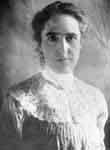|
|
Henrietta Swan Leavitt (July 4, 1868 – December 12, 1921) was an American astronomer, and the deaf[1] daughter of a Congregational church minister.[2] She was born in Lancaster, Massachusetts to an old Massachusetts Puritan family who had settled in the Massachusetts Bay Colony in the early part of the seventeenth century. (The family name was originally spelled Levet or Levett in early Massachusetts records.) She graduated from Radcliffe College (then called the Society for the Collegiate Instruction for Women) with an A.B. degree in 1892. Leavitt began work in 1893 at Harvard College Observatory as one of the women "computers" brought in by Edward Charles Pickering to measure and catalog the brightness of stars in the observatory's photographic plate collection. She noted thousands of variable stars in images of the Magellanic Clouds. In 1908 she published her results in the Annals of the Astronomical Observatory of Harvard College, noting that a few of the variables showed a pattern: brighter ones appeared to have longer periods. After further study, she confirmed in 1912 that the variable stars of greater intrinsic luminosity—actually Cepheid variables—did indeed have longer periods, and the relationship was quite close and predictable. This relationship provided an important yardstick for measuring distances in the Universe, if it could be calibrated. One year after Leavitt reported her results, Ejnar Hertzsprung determined the distance of several Cepheids in the Milky Way, and with this calibration the distance to any Cepheid could be determined. When Cepheids were detected in other galaxies such as the Andromeda Galaxy, the distance to those galaxies could also be determined. These distances settled the debate on whether the galaxies were external to the Milky Way or part of it. Leavitt worked sporadically during her time at Harvard, often sidelined by health problems and family obligations. But by 1921, when Harlow Shapley took over as director of the observatory, she was head of stellar photometry. She succumbed to cancer by the end of that year and was buried in the family plot at Cambridge Cemetery in Cambridge. "Sitting at the top of a gentle hill," writes George Johnson in his biography of Leavitt, "the spot is marked by a tall hexagonal monument, on top of which (cradled on a draped marble pedestal) sits a globe. Her uncle Erasmus (Darwin Leavitt Jr.) and his family are also buried there, along with other Leavitts. A plaque memorializing Henrietta and her two siblings who died so young, Mira and Roswell, is mounted directly below the continent of Australia. Off to one side, and more often visited, are the graves of Henry and William James." Awards and honors * The asteroid 5383 Leavitt and the Leavitt crater on the Moon are named in her honour. * Four years after her death, the Swedish mathematician Gösta Mittag-Leffler considered nominating her for the Nobel prize in physics, and wrote Shapley requesting more information on her work on Cepheid variables; and offering to send her his monograph on Sofia Kovalevskaya. Shapley replied, suggesting that the true credit belonged to his interpretation of her findings. She was never nominated; the Nobel Prize is not awarded posthumously.[3] Notes 1. ^ Henrietta Swan Leavitt, A deaf, female scientist—over 100 years ago!. Bloomfield Science Museum, Jeruselem. Retrieved on 18 May, 2007. 2. ^ Gregory M. Lamb. "Before computers, there were these humans...", Christian Science Monitor, July 5, 2005. Retrieved on 2007-05-18. 3. ^ Johnson, pp.118-9 References * Johnson, George (2005). Miss Leavitt's Stars: The Untold Story of the Woman Who Discovered How to Measure the Universe. New York: W.W. Norton & Company. ISBN 0-393-05128-5. * Lorenzen, Michael (1997). "Henrietta Swan Leavitt." In Notable Women in the Physical Sciences: A Biographical Dictionary. Edited by Barbara and Benjamin Shearer. Westport, CT: Greenwood Press, 233-37. ISBN 0-313-29303-1. Retrieved from "http://en.wikipedia.org/"
|
|
|||||||||||
